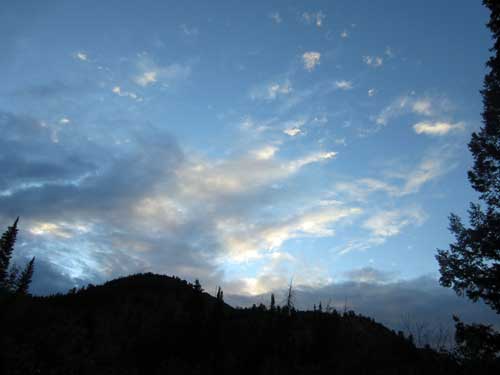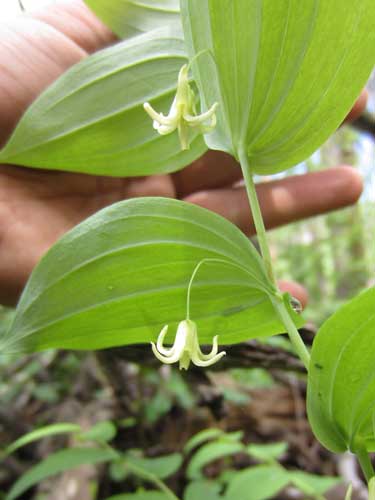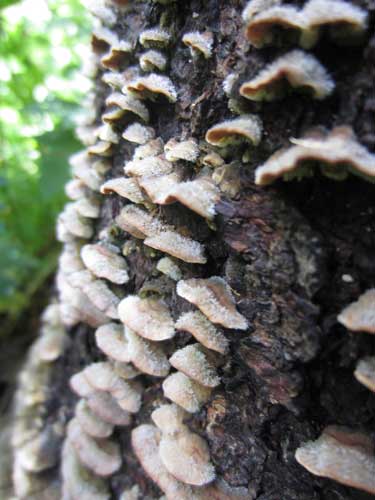Several storms swept through during the night, bringing lightning, thunder, torrential rain... and a leaking tent. By 5 am the birds were in full song and by 6 am the sky was blue again. We hung the tarp to dry, had some oatmeal for breakfast, then loaded up a small backpack, intent on doing the Elk Park trail.

A new day

Things dried very quickly in the sun


Jo digitally captures a minnow down at the stream.
We had only gone a short distance when we arrived at a river crossing. We hadn't taken our sandals with us, so we went back to the tent, fetched our gear, then returned to the river.

Sooooooo cooooooold!!!
We passed through some lush, wet forest and arrived at a large open meadow. We followed the trail across it which led us to another river crossing. It was much larger than all the other crossings we had done. That in and of itself wasn't an issue, but it was much deeper and the current was fairly strong. After some deliberation, we decided not to risk it.

The lush, clothes-drenching forest path

Some Angelica

You knew this shot had to be here!

The super sticky burs of Houndstongue



It may not look that bad in a still photo, but the river was moving rather quickly.
We returned to the meadow and, even though it was still rather early, had some lunch. We then wandered about aimlessly, sometimes following game trails, other times making our way back at the river to see if we could find an easier way across (no luck though).

Our view from lunch rock

Voles and pocket gophers live in tunnels underground. During winter when the ground is too cold to dig though, they tunnel through the snow (lining it with dirt and grass) as they browse for seeds, nuts and leaves around the subnivean layer (along the ground, under the snow). When the snow melts, the dirt drops and forms an above-ground network of odd trails.... or eskers.

A faint game trail that the deer and elk use

Another Ornate Checkered Beetle on some penstemon

The small male cones of the Ponderosa Pine (or western yellow pine) which bear the pollen...

... and a large, female woody cone. Each tree has both. Pollination occurs by wind.

It takes two years for a cone to mature.

A somewhat psycho-looking female Checkered White

Solomon's Seal has flowers that hang underneath the leaves.

This is possible a type of Chafer, a beetle in the Scarab family. In North America, they are commonly called June bugs or May beetles, a blackish or mahogany-colored beetle.

Trying to get to the river

Hmmm... still a bit too big to cross

Horsetail is an ancient, fern-related plant that loves wet areas. This is the only surviving family (with about 20 speices) of a line of plants going back 375 million years. Members of this family gave rise to many of our coal deposits.

It was still a bit early for the Bilberries (which are closely related to blueberries).

These are not berries! They are wasp eggs! The wasp injects a chemical into the leaf which in turn creates a structure called a gall. The gall provides food and shelter for the wasp larva inside.
We headed over to a steep slope of boulders, hoping to see (or at least hear) some picas or marmots. Unfortunately all was quiet... mostly. We did hear the call of some Red-tailed Hawks. Four of them circled overhead among the cliff top.



Clouds were once again starting to gather, so we began our leisurely return.... across the meadow, through the forest and back across the river.

Toupee rock!

We came across a campsite where people probably rode horses to as opposed to hiking in. We loaded up our backpack with all the trash we found.

This is a female Goldenrod Crab Spider (the males are much smaller). It is an ambush hunter, sitting patiently on a flower for an insect to come by. They can change color between white and yellow. To do this, they secrete a yellow pigment which is then absorbed into the normally white cells. If the spider dwells on a white flower, the yellow pigment is excreted. The color change from white to yellow takes 10 - 25 days, and the reverse about six days.

Deer Flies (or Yellow Flies) belong to the horse fly family. They come in a wide variety of colors and patterns. Their bite can be extremely painful.

Leaving the meadow

Getting ready to cross the river

Bracket fungi or shelf mushrooms aid in the decomposition of wood. They often signal that a tree has internal rot. Brackets can range from only a single row of a few caps, to dozens of rows that can weigh several hundred pounds.

A brilliant wild rose
By the time we arrived at the tent, it was clear a storm was imminent. It only rained lightly though, and within an hour and a half the sky was clear again.

From this...

... to this! Crazy weather!

